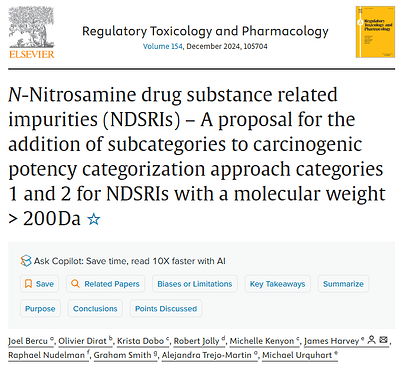Major league team of authors in this paper…
N-Nitrosamine drug substance related impurities (NDSRIs) – A proposal for the addition of subcategories to carcinogenic potency categorization approach categories 1 and 2 for NDSRIs with a molecular weight > 200 Da
Highlights
- CPCA defines Acceptable Intakes for NDSRIs based on chemical structure.
- CPCA refinement is proposed given historical rodent data and NDSRI molecular weights.
- CPCA Category 1/2 NDSRIs with MW > 200 Da could have Acceptable Intakes of 150 ng/day.
Abstract:
The carcinogenicity potency categorization approach (CPCA) derived and harmonized by Health Authorities was a significant milestone, as it defined molecular properties that allowed for the rapid evaluation of the chemical structures of N-nitrosamine drug substance related impurities (NDSRIs) and the assignment of associated lifetime Acceptable Intake (AI) limits to inform on appropriate impurity control strategies in certain drug products. Nonetheless, it is important to continue to refine and improve on the CPCA based upon data-derived evidence. Herein, we focus on the default CPCA AI for NDSRIs, which is largely based on the small molecule N-nitrosamines (NAs). Considering the carcinogenic potency of NAs with a molecular weight >200 Da (NDSRIs molecular weight is typically 200–600 Da), we propose that in the absence of any compound specific data, the lowest lifetime Acceptable Intake for NAs, such as NDSRIs, should be 10x less (i.e., 150 ng/day) than the ICH M7 Threshold of Toxicological Concern of 1500 ng/day, (even for NDSRIs that are considered CPCA Category 1 and 2) which would conservatively result in a theoretical cancer risk of <1 in 100,000.
